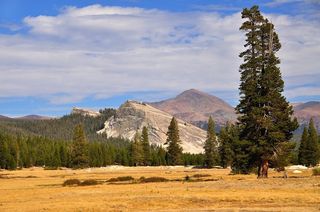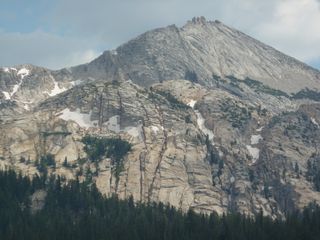Secrets Cracked in Yosemite's Tuolumne Meadows

The broad, grassy plain of Yosemite National Park's Tuolumne Meadows is a welcome stop for visitors driving California's steep and winding Highway 120.
But the wildflower-studded field is an oddball in Yosemite's iconic landscape of deep valleys and rugged peaks. The flat valley floor is a striking contrast to the smooth granite domes and finlike ridges that surround the valley like sentinels. Geologists now say the answer to this long-standing puzzle lies in the molten rock that shaped the Sierra Nevada mountain range.
Granite near Tuolumne Meadows is shot through with unusual clusters of cracks, according to findings published in the November 2014 issue of GSA Today. When ice age glaciers carved Yosemite's distinctive features, flowing ice easily scooped out the shattered granite, leaving only intact rock behind, the researchers think. [Photos: The World's Weirdest Geological Formations]
"We've known for a long time that granite and glaciers played a fundamental role in the history of Tuolumne Meadows, but only recently have we recognized this relatively unique style of fracturing and how it influences the landscape in this popular location," said lead study author Richard Becker, a doctoral student in geomorphology at the University of Wisconsin-Madison (UW).
Dramatic history
The Sierra Nevada mountains are glued together by large masses of cooled magma called plutons. Each pluton was once a blob of rising molten rock that stalled underground and slowly crystallized miles from the surface.
Several plutons form the stunning domes and steep walls of Yosemite National Park, each one overlapping the next, like a pile of sleeping puppies. One of the youngest, called the Cathedral Peak granodiorite, crosses through the Tuolumne Meadows region. (A granodiorite is a gray and white rock similar to granite.)
Sign up for the Live Science daily newsletter now
Get the world’s most fascinating discoveries delivered straight to your inbox.
The Cathedral Peak granodiorite was shattered and cracked about 85 million years ago, when new magma pushed upward into the cooling pluton, according to earlier research by Becker's UW colleagues. Gas or fluids from the younger magma blasted open escape routes in the older granite.
"These volatiles explosively fractured the rock," Becker told Live Science.
The peculiar cracks, called tabular fracture clusters (TFCs), are tightly spaced within Tuolumne Meadows and few and far between elsewhere. The clusters are zones of intensely fractured rock about 3 feet to 320 feet long (3 to 100 meters), with at least four cracks within a 4-inch (10 centimeters) span. The researchers say the valley's vanished rock was likely pulverized, too. Clumps of clusters plunge toward the meadows on rocky slopes bordering the valley. "When we go to higher elevations, we see TFCs heading straight for the valley air, so we infer that the ghost rocks were filled with TFCs as well," Becker said.

Ice age story
Glaciers plucked away the granodiorite that once covered Tuolumne Meadows between 30,000 to 10,000 years ago. Piles of river and glacial deposits now obscure the valley's rocky floor. But the few granite outcrops that do bob above the sediment are "absolutely hammered" with tabular fracture clusters, Becker said.
The position of the fractures was also essential in shaping Tuolumne Meadows, according to Becker's new research.
The Tuolumne Meadows cracks were oriented perpendicular to glaciers that flowed through the region, the study reports. The blemished bedrock was likely a chessboard of fractures, easily eroded compared to its more intact neighbors.
North and south of the valley, where the fractures ran parallel to the ice flow, the glaciers chiseled away loose rock but left behind the solid rock in between, creating strong, finlike ridges such as Matthes Crest. These vertical walls are now popular with rock climbers.
"All the great climbing in Tuolumne Meadows in the high country is linked to this situation," Becker said. And to the east and west rise the sturdy lumps of Lembert Dome and Pothole Dome, both nearly untouched by tabular fracture clusters.
While Becker and his colleagues say glaciers likely account for the flat valley, there are other candidates for shaping the landscape, such as the Tuolumne River. For instance, the fracture sets could have also speeded erosion by water, helping the current wash away unstable rock.
Becker said the profound influence of fractures in Tuolumne Meadows make the features worth investigating elsewhere. "They could play an important role in carving granite landscapes," he said. "I think we should be looking for these features elsewhere in the world."
Follow Becky Oskin @beckyoskin. Follow Live Science @livescience, Facebook & Google+. Originally published on Live Science.

Most Popular



